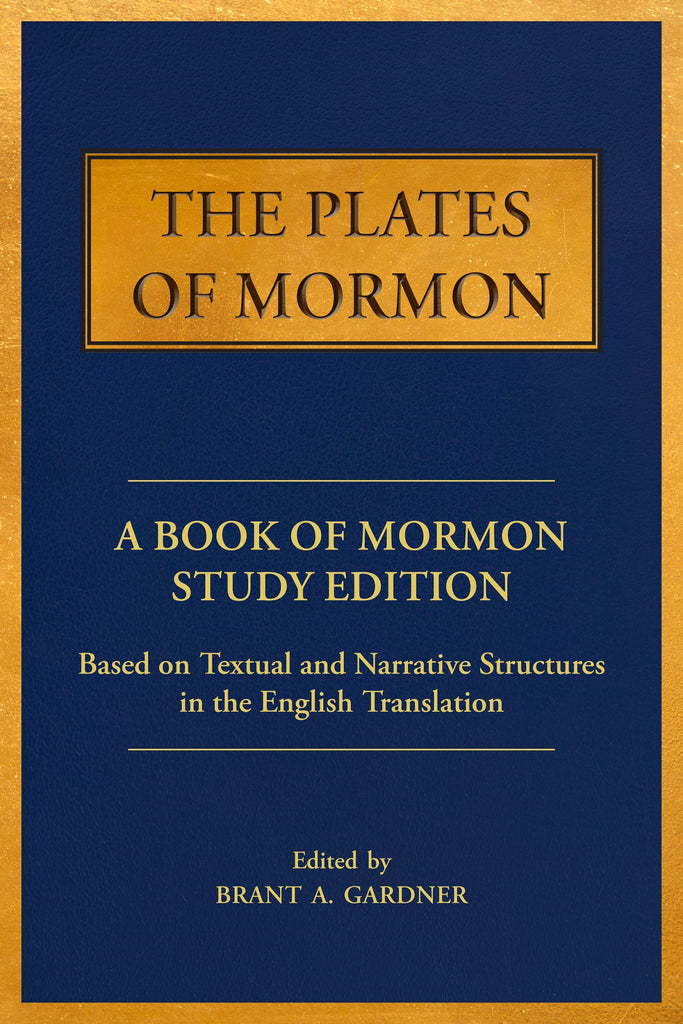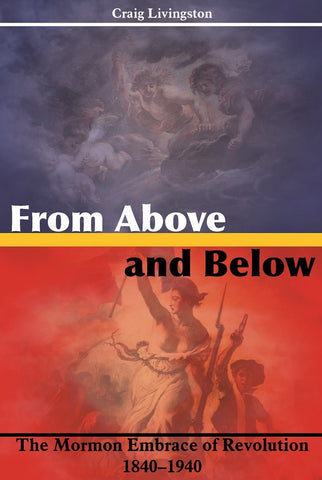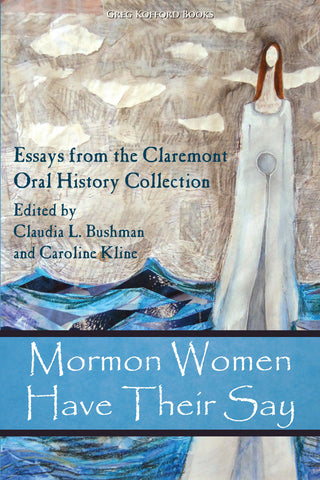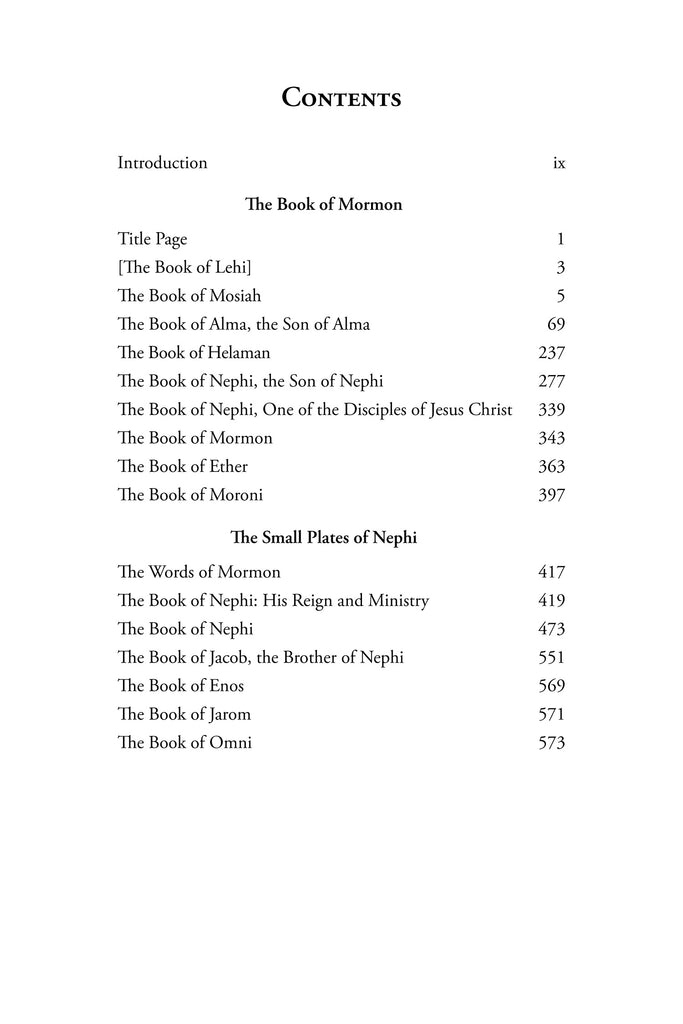The Plates of Mormon: A Book of Mormon Study Edition Based on Textual and Narrative Structures in the English Translation
$34.95
edited by Brant A. Gardner
Now Available !

Companion volume: Engraven Upon Plates, Printed Upon Paper: Textual and Narrative Structures of the Book of Mormon
- “Encountering the Book of Mormon's text arranged according to its own internal clues is like listening to Mormon reading it aloud to us across the millennia. . . . This is the study edition I will be using.” — Don Bradley
- “Readers will engage anew with the text of the Book of Mormon in this logically and creatively reformatted presentation, supported by highly insightful footnotes. There is much to be gained from this innovative contribution to Book of Mormon studies.” — Kerry Hull
- “Highly recommended to any and all readers who want to more deeply engage the text of the Book of Mormon. . . . A remarkable achievement.” — Nicholas J. Frederick
- “Provides a new and enjoyable experience, one which rewards its readers with new insights as the familiar chapter-and-verse structure is shaken up.” — Jared Riddick



Available in ebook for Kindle, Apple, Google Play, and Kobo.
Also available through Deseret Book and Amazon.
Download a free sample preview.
Book Description:
For nearly two centuries, Latter-day Saints have been reading the Book of Mormon through multiple changes in its punctuation, formatting, and versification. The Plates of Mormon: A Book of Mormon Study Edition Based on Textual and Narrative Structures in the English Translation offers a new perspective on this book of scripture by seeking to align its English translation with the inaccessible golden plates from which that translation was made. Originally punctuated and formatted by the 1830 first edition’s compositor, John H. Gilbert, who had to add punctuation and paragraphs to the text to make it more reader-friendly, this study edition meticulously returns to this issue by reexamining punctuation and paragraphs to enhance readability while maintaining faithfulness to the source material. Utilizing insights explored in his companion volume, Engraven Upon Plates, Printed Upon Paper: Textual and Narrative Structures of the Book of Mormon, editor Brant A. Gardner also addresses issues of spelling, grammar, alterations, deletions, and paratextual information, providing readers with a deeper understanding of the Book of Mormon's composition and the principles guiding this edition's editorial decisions.
Additionally, this edition examines narrative and literary structures in its translation to best represent how Mormon’s ancient writings were recorded on his golden plates. It does so not only by removing modern summaries and versification formatting, but also by returning the text to its original chapters and relocating the small plates section outside of Mormon’s intended record. It also highlights the logic behind punctuation, paragraphing, chapters, and headers, helping readers gain a more profound appreciation for the text's nuances. If you're interested in the Book of Mormon's origins, textual structure, and the thoughtful decisions made in presenting it, this edition provides valuable insights and a fresh perspective on this sacred text. It is a must-read for those seeking to explore the Book of Mormon anew.
Q&A with the Author:
.
Q: With The Plates of Mormon and Engraven Upon Plates, Printed Upon Paper you have now published ten volumes on the Book of Mormon. What started you on your own path in Book of Mormon studies, and is there a particular approach to the text that you like to focus on?
A: The most definable beginning point was when I was asked to do a weekly online article on the Book of Mormon. I decided to do an in-depth commentary that used Mesoamerica (my academic emphasis) as a plausible background. That project became Second Witness some twelve years later.
I take the Book of Mormon’s claims about itself seriously. For me, that means I can ask why a particular author wrote what he did in the order he did and apply human logic and understanding to the process. Too often believers in the text assume that we have the text because God wanted it that way. That isn’t the way the Bible was created, and that isn’t the process described in the Book of Mormon. That doesn’t preclude inspiration—but that inspiration always came to and through human hands.
Q: What is the relationship between Plates and Engraven? Did you begin one before the other, or were they conceived and worked on simultaneously?
A: That is a hard and complicated question. I worked on many of the ideas that resulted in the way Plates is formatted prior to beginning that project. However, after it's first iteration, the manuscript sat on my hard drive for at least a year. Engraven was started after that, but I worked on a revision of my original work on Plates about the same time.
Q: How does The Plates of Mormon differ from other study editions of the Book of Mormon?
A: Most study editions begin with either the most recent version under Church copyright or the public domain 1920 edition, and they are generally focused on devotional study with interpretive commentary for that purpose. Royal Skousen’s The Earliest Text is the closest to what I am doing with Plates, but there are still differences. Skousen’s book attempts to get back to the dictation and presents the text as “sense-lines” void of punctuation and formatting.
This edition differs from all others in that it has sought to present the text as its primary author and editor, Mormon, conceived of his book. As many are aware, when the Printer's Manuscript was handed over to Grandin Print Shop for publication, it was a flowing text that lacked not only punctuation and uniform capitalization but also any clear distinction between book titles, headers, and paragraphs. Those were all added by Grandin's compositor John Gilbert and have largely remained as they were since that first 1830 edition. Plates seeks to revise Gilbert's work by taking the raw text of the Book of Mormon and modifying both its sentence construction and presentation based on literary and textual structures within the text. For example, there are also some textual markers that I believe were inherited from the original Nephite text that were remnants of a culture in transition from an oral to a literature culture. “And it came to pass” has come to have a much more important meaning for me, and I wish we would restore those few times that the phrase has been removed. In general, I find I like the manuscript version of the Book of Mormon better than the modern edition which has made a few slight changes.
Furthermore, it seems rather clear that Mormon was not anticipating Martin Harris's unfortunate loss of the so-called lost 116 pages and the subsequent use of the small plates of Nephi to replace the missing text. Thus, this edition has moved the small plates' text to the back as Mormon himself intended (similar to appendices in modern books), with his Words to introduce the "great things written upon them." I believe reading the small plates in this context highlights the unique and different role Nephi and others had for their writings that we might otherwise miss by reading them as an intentional beginning to the Book of Mormon.
Q: Is there anything in particular about the Book of Mormon that stuck out to you while you were working on these books that you hadn’t fully recognized before?
A: Almost every time I approach the Book of Mormon, I am learning things I hadn’t seen before. I had previously understood the narrative function of “and it came to pass,” but working on Plates brought out the companion phrase “and now” which works in conjunction with “and it came to pass” to move the action of the text through time, or to show events happening during the same time.
Engraven is pretty much all things I have learned about the text, though some of the ideas have been cooking for a long time and some have seen light in different ways.
Q: What was the biggest challenge you faced while punctuating and formatting the Printer’s Manuscript for The Plates of Mormon?
A: Staying awake? What a generally boring task! It was fascinating to learn that after however many times I have read the Book of Mormon and how many times I have tried to read it closely—there were new things that I had never seen before. Sometimes it was incomplete sentences. In one case, it was an unfortunate punctuation that created the strange statement that Christ had never shown himself on earth. That one is still in the current text! I note it in the Introduction to Plates, so maybe we can get people to read at least the introduction to find out which verse.
Q: In Engraven Upon Plates, Printed Upon Paper you lean in heavily on Mormon, Nephi, and others being very real persons working very real records. Are there any implications of this approach that previous scholars of the Book of Mormon haven’t fully considered?
A: I think the question pertains more to a believing audience than an academic one. The non-believing academics can read as though there were real writers, but it is a convenient fiction. For believers, I think the difference is that many accept that there were real people, but have them sacralized almost to the point where they are sacred symbols more than human writers. By accepting Mormon, Nephi, and others as real writers, we can look at how they accomplished their work without assuming that that they were merely puppets controlled by the divine hand.
Q: What from these books do you hope that those who do not believe in the ancient historicity of the Book of Mormon can nevertheless find valuable and insightful to their understanding of that book of scripture?
A: Plates of Mormon allows the easier answer. That book can be used as a tool to understand the text of the Book of Mormon as it was presented in 1829.
Because Engraven divides the text into creative layers. The modern translation layer is where most nonbelieving academics spend their time. However, the whole text is essentially descriptive without declaring that those descriptions prove historicity. I assume it in the way I categorize the elements examined, but those elements can be examined and understood quite apart from the boxes in which I have placed them.
Praise for The Plates of Mormon:
“Brant Gardner's meticulous work introduces us to the Book of Mormon again for the first time. Encountering the Book of Mormon's text arranged according to its own internal clues is like listening to Mormon reading it aloud to us across the millennia. An invaluable aid in understanding the Book of Mormon text as its original authors intended. This is the study edition I will be using.” — Don Bradley, author, The Lost 116 Pages: Reconstructing the Book of Mormon's Missing Stories
“Brant Gardner’s The Plates of Mormon: A Book of Mormon Study Edition is highly recommended to any and all readers who want to more deeply engage the text of the Book of Mormon. In this book, Gardner takes readers back to the early stages of the coming forth of the Book of Mormon. He expertly works through the book’s transmission, bringing to life the words of Mormon, Nephi, and others. Gardner skillfully integrates the earliest manuscripts of the Book of Mormon while also highlighting the hundreds of places where the Book of Mormon interacts with the Bible. A remarkable achievement.” — Nicholas J. Frederick, Associate Professor of Ancient Scripture, Brigham Young University, and author of The Bible, Mormon Scripture, and the “Rhetoric of Allusivity”
“This volume is a welcome addition to other recent study editions of the Book of Mormon. Relying upon the Printer’s Manuscript, Gardner succeeds in making the text more intelligible and accessible to readers through a careful restructuring of punctuation, sentences, paragraphs, and narrative blocks, as well as by beginning with the large plates followed by the small. Readers will engage anew with the text of the Book of Mormon in this logically and creatively reformatted presentation, supported by highly insightful footnotes. There is much to be gained from this innovative contribution to Book of Mormon studies.” — Kerry Hull, co-editor, A Hundredth Part: Exploring the History and Teachings of the Book of Mormon
“Brant Gardner’s The Plates of Mormon: A Book of Mormon Study Edition is an excellent addition to the small but growing number of scholarly editions of the Nephite record. Working from the Printer’s Manuscript, Gardner has undertaken the labor of its first compositor, John H. Gilbert, by punctuating and paragraphing the Book of Mormon text afresh and providing a new and enjoyable experience, one which rewards its readers with new insights as the familiar chapter-and-verse structure is shaken up. Most notable is the re-arrangement by order of translation, allowing readers to experience the Book of Mormon as its original authors intended. Footnotes throughout provide interesting history and insights from the Original and Printers’ Manuscripts, as well as noting quotations, allusions, and echoes to the language of the King James Bible, enriching the reader’s experience. Having published and presented on the Book of Mormon in academic settings for over two decades, Brant Gardner has here produced a study edition of the Book of Mormon worthy of inclusion on the shelves of every serious student of the keystone scripture.” — Jared Riddick, librarian and archivist at Scripture Central
"I am . . . a fan of Gardner’s meticulous and understated scholarship. Notwithstanding the occasional flash of irrepressible, incisive wit, Gardner’s writing works hard to avoid drawing attention to itself. His tone is more reminiscent of a deliberate and judicious Atticus Finch than the exclamatory and undemanding popular authors so beloved by focus groups. Nevertheless, his content is fresh, well-sourced, and on point. His footnotes—unfailingly thorough, gracious, and penetrating with just enough snark to keep things interesting—are an ideal tutor for those wishing to go further." — Kimberley Heuston, Interpreter
About the Author:
 Brant A. Gardner earned his M.S. in anthropology (specializing in Mesoamerican ethnohistory) from the State University of New York at Albany. He is the author of the six-volume Second Witness: Analytical and Contextual Commentary on the Book of Mormon, The Gift and Power: Translating the Book of Mormon, and Traditions of the Fathers: The Book of Mormon as History. He has presented papers at the Foundation for Apologetic Information and Research (FAIR), the Book of Mormon Archaeological Symposium, and Sunstone. His other published works include chapters in Estudios de Cultura Nahuatl and Symbol and Meaning beyond the Closed Community: Essays in Mesoamerican Ideas, and articles in the FARMS Review, Sunstone, The Interpreter, and Meridian Magazine.
Brant A. Gardner earned his M.S. in anthropology (specializing in Mesoamerican ethnohistory) from the State University of New York at Albany. He is the author of the six-volume Second Witness: Analytical and Contextual Commentary on the Book of Mormon, The Gift and Power: Translating the Book of Mormon, and Traditions of the Fathers: The Book of Mormon as History. He has presented papers at the Foundation for Apologetic Information and Research (FAIR), the Book of Mormon Archaeological Symposium, and Sunstone. His other published works include chapters in Estudios de Cultura Nahuatl and Symbol and Meaning beyond the Closed Community: Essays in Mesoamerican Ideas, and articles in the FARMS Review, Sunstone, The Interpreter, and Meridian Magazine.
More Information:
589 pages
ISBN: 978-1-58958-776-2 (paperback)









Share this item: